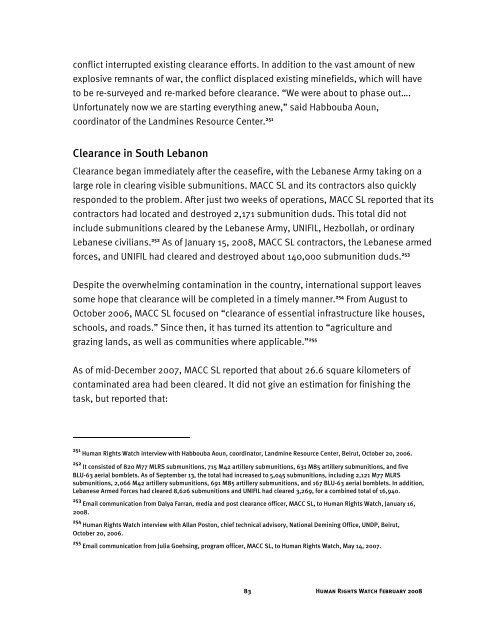Flooding South Lebanon - Human Rights Watch
Flooding South Lebanon - Human Rights Watch
Flooding South Lebanon - Human Rights Watch
You also want an ePaper? Increase the reach of your titles
YUMPU automatically turns print PDFs into web optimized ePapers that Google loves.
conflict interrupted existing clearance efforts. In addition to the vast amount of new<br />
explosive remnants of war, the conflict displaced existing minefields, which will have<br />
to be re-surveyed and re-marked before clearance. “We were about to phase out….<br />
Unfortunately now we are starting everything anew,” said Habbouba Aoun,<br />
coordinator of the Landmines Resource Center. 251<br />
Clearance in <strong>South</strong> <strong>Lebanon</strong><br />
Clearance began immediately after the ceasefire, with the Lebanese Army taking on a<br />
large role in clearing visible submunitions. MACC SL and its contractors also quickly<br />
responded to the problem. After just two weeks of operations, MACC SL reported that its<br />
contractors had located and destroyed 2,171 submunition duds. This total did not<br />
include submunitions cleared by the Lebanese Army, UNIFIL, Hezbollah, or ordinary<br />
Lebanese civilians. 252 As of January 15, 2008, MACC SL contractors, the Lebanese armed<br />
forces, and UNIFIL had cleared and destroyed about 140,000 submunition duds. 253<br />
Despite the overwhelming contamination in the country, international support leaves<br />
some hope that clearance will be completed in a timely manner. 254 From August to<br />
October 2006, MACC SL focused on “clearance of essential infrastructure like houses,<br />
schools, and roads.” Since then, it has turned its attention to “agriculture and<br />
grazing lands, as well as communities where applicable.” 255<br />
As of mid-December 2007, MACC SL reported that about 26.6 square kilometers of<br />
contaminated area had been cleared. It did not give an estimation for finishing the<br />
task, but reported that:<br />
251 <strong>Human</strong> <strong>Rights</strong> <strong>Watch</strong> interview with Habbouba Aoun, coordinator, Landmine Resource Center, Beirut, October 20, 2006.<br />
252 It consisted of 820 M77 MLRS submunitions, 715 M42 artillery submunitions, 631 M85 artillery submunitions, and five<br />
BLU-63 aerial bomblets. As of September 13, the total had increased to 5,045 submunitions, including 2,121 M77 MLRS<br />
submunitions, 2,066 M42 artillery submunitions, 691 M85 artillery submunitions, and 167 BLU-63 aerial bomblets. In addition,<br />
Lebanese Armed Forces had cleared 8,626 submunitions and UNIFIL had cleared 3,269, for a combined total of 16,940.<br />
253 Email communication from Dalya Farran, media and post clearance officer, MACC SL, to <strong>Human</strong> <strong>Rights</strong> <strong>Watch</strong>, January 16,<br />
2008.<br />
254 <strong>Human</strong> <strong>Rights</strong> <strong>Watch</strong> interview with Allan Poston, chief technical advisory, National Demining Office, UNDP, Beirut,<br />
October 20, 2006.<br />
255 Email communication from Julia Goehsing, program officer, MACC SL, to <strong>Human</strong> <strong>Rights</strong> <strong>Watch</strong>, May 14, 2007.<br />
83<br />
<strong>Human</strong> <strong>Rights</strong> <strong>Watch</strong> February 2008
















